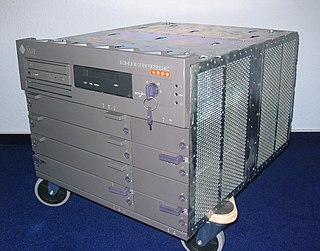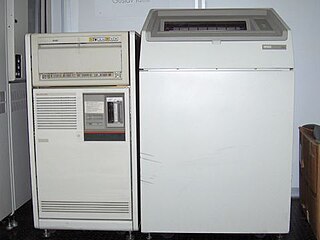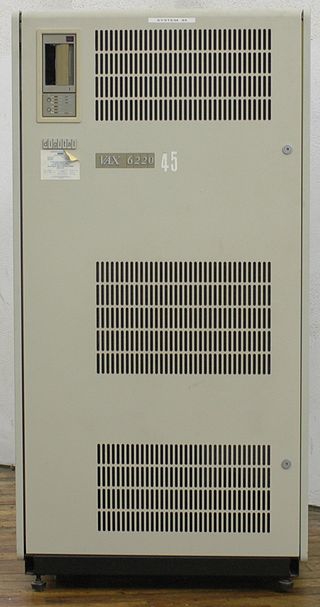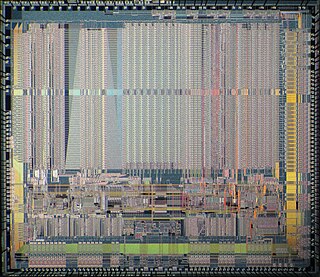Related Research Articles

Digital Equipment Corporation, using the trademark Digital, was a major American company in the computer industry from the 1960s to the 1990s. The company was co-founded by Ken Olsen and Harlan Anderson in 1957. Olsen was president until he was forced to resign in 1992, after the company had gone into precipitous decline.

VAX is a series of computers featuring a 32-bit instruction set architecture (ISA) and virtual memory that was developed and sold by Digital Equipment Corporation (DEC) in the late 20th century. The VAX-11/780, introduced October 25, 1977, was the first of a range of popular and influential computers implementing the VAX ISA. The VAX family was a huge success for DEC, with the last members arriving in the early 1990s. The VAX was succeeded by the DEC Alpha, which included several features from VAX machines to make porting from the VAX easier.

Sun Enterprise is a range of UNIX server computers produced by Sun Microsystems from 1996 to 2001. The line was launched as the Sun Ultra Enterprise series; the Ultra prefix was dropped around 1998. These systems are based on the 64-bit UltraSPARC microprocessor architecture and related to the contemporary Ultra series of computer workstations. Like the Ultra series, they run Solaris. Various models, from single-processor entry-level servers to large high-end multiprocessor servers were produced. The Enterprise brand was phased out in favor of the Sun Fire model line from 2001 onwards.

The DECstation was a brand of computers used by DEC, and refers to three distinct lines of computer systems—the first released in 1978 as a word processing system, and the latter two both released in 1989. These comprised a range of computer workstations based on the MIPS architecture and a range of PC compatibles. The MIPS-based workstations ran ULTRIX, a DEC-proprietary version of UNIX, and early releases of OSF/1.

The VAXstation is a discontinued family of workstation computers developed and manufactured by Digital Equipment Corporation using processors implementing the VAX instruction set architecture. VAXstation systems were typically shipped with either the OpenVMS or ULTRIX operating systems. Many members of the VAXstation family had corresponding MicroVAX variants, which primarily differ by the lack of graphics hardware.
DECsystem was a line of server computers from Digital Equipment Corporation. They were based on MIPS architecture processors and ran DEC's version of the UNIX operating system, called ULTRIX. They ranged in size from workstation-style desktop enclosures to large pedestal cabinets.

Am2900 is a family of integrated circuits (ICs) created in 1975 by Advanced Micro Devices (AMD). They were constructed with bipolar devices, in a bit-slice topology, and were designed to be used as modular components each representing a different aspect of a computer control unit (CCU). By using the bit slicing technique, the Am2900 family was able to implement a CCU with data, addresses, and instructions to be any multiple of 4 bits by multiplying the number of ICs. One major problem with this modular technique was that it required a larger number of ICs to implement what could be done on a single CPU IC. The Am2901 chip included an arithmetic logic unit (ALU) and 16 4-bit processor register slices, and was the "core" of the series. It could count using 4 bits and implement binary operations as well as various bit-shifting operations. The Am2909 was a 4-bit-slice address sequencer that could generate 4-bit addresses on a single chip, and by using n of them, it was able to generate 4n-bit addresses. It had a stack that could store a microprogram counter up to 4 nest levels, as well as a stack pointer.

The NVAX is a CMOS microprocessor developed and produced by Digital Equipment Corporation (DEC) that implemented the VAX instruction set architecture (ISA). A variant of the NVAX, the NVAX+, differed in the bus interface and external cache supported, but was otherwise identical in regards to microarchitecture. The NVAX+ was designed to have the same bus as the DECchip 21064, allowing drop-in replacement.

The MicroVAX is a discontinued family of low-cost minicomputers developed and manufactured by Digital Equipment Corporation (DEC). The first model, the MicroVAX I, was first shipped in 1984. They used processors that implemented the VAX instruction set architecture (ISA) and were succeeded by the VAX 4000. Many members of the MicroVAX family had corresponding VAXstation variants, which primarily differ by the addition of graphics hardware. The MicroVAX family supports Digital's VMS, ULTRIX and VAXELN operating systems. Prior to VMS V5.0, MicroVAX hardware required a dedicated version of VMS named MicroVMS.
The DEC 7000 AXP and DEC 10000 AXP are a series of high-end multiprocessor server computers developed and manufactured by Digital Equipment Corporation, introduced on 10 November 1992. These systems formed part of the first generation of systems based on the 64-bit Alpha AXP architecture and at the time of introduction, ran Digital's OpenVMS AXP operating system, with DEC OSF/1 AXP available in March 1993. They were designed in parallel with the VAX 7000 and VAX 10000 minicomputers, and are identical except for the processor module(s) and supported bus interfaces. A field upgrade from a VAX 7000/10000 to a DEC 7000/10000 AXP was possible by means of swapping the processor boards.
The VAX 4000 is a discontinued family of low-end minicomputers developed and manufactured by Digital Equipment Corporation using microprocessors implementing the VAX instruction set architecture (ISA). The VAX 4000 succeeded the MicroVAX family, and shipped with the OpenVMS operating system. It was the last family of low-end VAX systems, as the platform was discontinued by Compaq.

The VAX 6000 is a discontinued family of minicomputers developed and manufactured by Digital Equipment Corporation (DEC) using processors implementing the VAX instruction set architecture (ISA). Originally, the VAX 6000 was intended to be a mid-range VAX product line complementing the VAX 8000, but with the introduction of the VAX 6000 Model 400 series, the older VAX 8000 was discontinued in favor of the VAX 6000, which offered slightly higher performance for half the cost. The VAX 6000 family supports Digital's VMS and ULTRIX operating systems.
The VAX 7000 and VAX 10000 are a discontinued family of high-end multiprocessor minicomputers developed and manufactured by Digital Equipment Corporation (DEC), introduced in July 1992. These systems use NVAX microprocessors implementing the VAX instruction set architecture, and run the OpenVMS operating system.

The VAX 8000 is a discontinued family of superminicomputers developed and manufactured by Digital Equipment Corporation (DEC) using processors implementing the VAX instruction set architecture (ISA).
The VAX 9000 is a discontinued family of mainframes developed and manufactured by Digital Equipment Corporation (DEC) using custom ECL-based processors implementing the VAX instruction set architecture (ISA). Equipped with optional vector processors, they were marketed into the supercomputer space as well. As with other VAX systems, they were sold with either the VMS or Ultrix operating systems.
The VAXft was a family of fault-tolerant minicomputers developed and manufactured by Digital Equipment Corporation (DEC) using processors implementing the VAX instruction set architecture (ISA). "VAXft" stood for "Virtual Address Extension, fault tolerant". These systems ran the OpenVMS operating system, and were first supported by VMS 5.4. Two layered software products, VAXft System Services and VMS Volume Shadowing, were required to support the fault-tolerant features of the VAXft and for the redundancy of data stored on hard disk drives.
The Digital Storage Systems Interconnect (DSSI) is a computer bus developed by Digital Equipment Corporation for connecting storage devices and clustering VAX systems. It was designed as a smaller and lower-cost replacement for the earlier DEC Computer Interconnect that would be more suitable for use in office environments. DSSI was superseded by Parallel SCSI.

Rigel was a microprocessor chip set developed and fabricated by Digital Equipment Corporation (DEC) that implemented the VAX instruction set architecture (ISA). It was introduced on 11 July 1989 with the introduction of the VAX 6000 Model 400, the first system to feature the chip set. Rigel was also used in the VAX 4000 Model 300 and VAXstation 3100 Model 76. Production Rigel CPUs were rated at 35 to 43 MHz.
The ICL DRS was a range of departmental computers from International Computers Limited (ICL). Standing originally for Distributed Resource System, the full name was later dropped in favour of the abbreviation.
References
- ↑ "DIGITAL$RESOURCES: Qbus Systems and Options". hampage.hu. Retrieved 2019-09-09.
- ↑ "VAX 4000 Model 300 Operation (EK-336AC-OP-00)" (PDF). June 1991. Retrieved 2019-09-09.